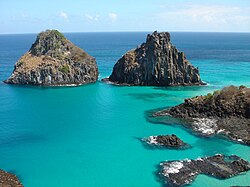This article needs additional citations for verification .(May 2020) |
An emergent coastline is a stretch along the coast that has been exposed by the sea by a relative fall in sea levels by either isostasy or eustasy.[ not verified in body ]
Emergent coastline are the opposite of submergent coastlines, which have experienced a relative rise in sea levels. [1]
The emergent coastline may have several specific landforms:
- Raised beach or machair
- Wave cut platform
- Sea cave such as King's Cave, Isle of Arran
The Scottish Gaelic word machair or machar refers to a fertile low-lying raised beach found on some of the coastlines of Ireland and Scotland (especially the Outer Hebrides).
Hudson Bay, in Canada's north, is an example of an emergent coastline. It is still emerging by as much as 1 cm per year.[ citation needed ] Another example of emergent coastline is the Eastern Coastal Plains of the Indian subcontinent.

